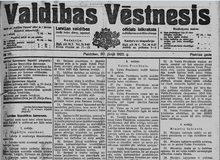| Constitution of Republic of Latvia | |
|---|---|
 Constitution of Latvia published in the government newspaper Valdības Vēstnesis on 30 June 1922. | |
| Overview | |
| Jurisdiction | Latvia |
| Created | 15 February 1922 |
| Date effective | 7 November 1922 |
| System | Constitutional parliamentary republic |
| Chambers | Unicameral |
| Executive | Cabinet Ministers |
| Judiciary | Supreme, Constitutional |
| History | |
| Amendments | 15 |
| Author(s) | Constitutional Assembly of Latvia |
| Signatories | 150 |
| Full text | |
 |
|---|
The Constitution of Latvia (Latvian: Satversme, Livonian: Pūojpandõks)[1] is the fundamental law of the Republic of Latvia. Satversme is the oldest Eastern or Central European constitution still in force and the sixth oldest still-functioning republican basic law in the world.[2] It was adopted, as it states itself in the text, by the people of Latvia, as represented in the Constitutional Assembly of Latvia, on 15 February 1922 and came into force on 7 November 1922. It was heavily influenced by Germany's Weimar Constitution and the Swiss Federal Constitution. The constitution establishes the main bodies of government (Saeima, State President, Cabinet of Ministers, Courts, State Auditor); it consists of 116 articles arranged in eight chapters.
Although the initial text consisted of two parts, the second part - which regulated citizens' rights, freedoms and obligations - failed to pass by just a few votes; the chapter on fundamental human rights was added only by a constitutional amendment in 1998.
After the 1934 Latvian coup d'état by Prime Minister of Latvia Kārlis Ulmanis, Satversme was suspended and government assumed the law-giving functions of the Saeima. This situation continued until June 17, 1940, when the Soviet Union occupied Latvia, destroyed the existing regime, and incorporated the Latvian SSR into the USSR on August 5. A new, Soviet-style constitution was then introduced.
On May 4, 1990 the Supreme Soviet of LSSR passed the declaration On the Restoration of Independence of the Republic of Latvia, declaring the 1940 Soviet annexation of Latvia illegal (as it was done by ignoring Satversme), and therefore the Satversme and Republic of Latvia still existed de jure. Only articles 1, 2, 3 and 6 of Satversme were reintroduced at that time by the declaration; the constitution was fully reintroduced only by the first assembly of the 5th Saeima in 1993.
- ^ "Latvijas Republikas Satversme = Latvejis Republikys Satversme = Leţmō Republik Pūojpandõks = Constitution de la République de Lettonie = The Constitution of the Republic of Latvia = Verfassung der Republik Lettland = Läti Vabariigi põhiseadus = Latvijos Respublikos Konstitucija = Konstitucija Latvijskoj Respubliki | WorldCat.org". search.worldcat.org. Retrieved 2024-01-31.
- ^ Jarinovska, K. "Popular Initiatives as Means of Altering the Core of the Republic of Latvia", Juridica International. Vol. 20, 2013. p. 152 ISSN 1406-5509